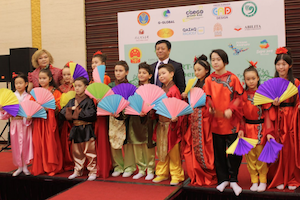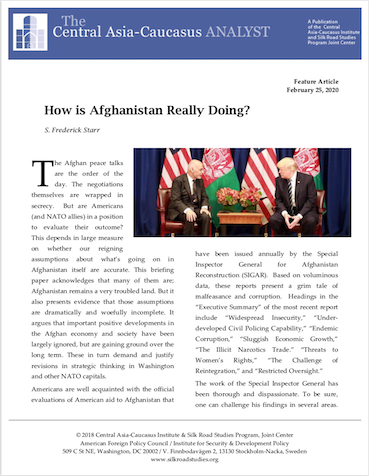New Strategy, Old Game: The Realigning Geopolitics of Central Asia
By Farkhod Tolipov
March 26, 2020, the CACI Analyst
Three recent events have recently drawn the attention of the public, experts and official circles in Central Asia: U.S. Secretary of State Mike Pompeo’s visits to Kazakhstan and Uzbekistan and his meetings with the presidents of these states on 1-4 February 2020; the “C5+1” meeting in Tashkent; and the announcement of a new U.S. Strategy for Central Asia 2019-2025. In Central Asian capitals as well as in Moscow and Beijing, these three events served to alter the existing geopolitical calculus: Washington effectively reminded Central Asians and U.S. rivals Russia and China of itself and its interests. It thus seems that the old Great Game continues.
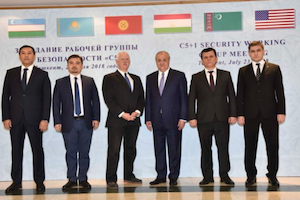
How is Afghanistan Really Doing?
How is Afghanistan Really Doing?
By: S. Frederick Starr
The Afghan peace talks are the order of the day. The negotiations themselves are wrapped in secrecy. But are Americans (and NATO allies) in a position to evaluate their outcome? This depends in large measure on whether our reigning assumptions about what’s going on in Afghanistan itself are accurate. This briefing paper acknowledges that many of them are; Afghanistan remains a very troubled land. But it also presents evidence that those assumptions are dramatically and woefully incomplete. It argues that important positive developments in the Afghan economy and society have been largely ignored, but are gaining ground over the long term. These in turn demand and justify revisions in strategic thinking in Washington and other NATO capitals.
Americans are well acquainted with the official evaluations of American aid to Afghanistan that have been issued annually by the Special Inspector General for Afghanistan Reconstruction (SIGAR). Based on voluminous data, these reports present a grim tale of malfeasance and corruption. Headings in the “Executive Summary” of the most recent report include “Widespread Insecurity,” “Under- developed Civil Policing Capability,” “Endemic Corruption,” “Sluggish Economic Growth,” “The Illicit Narcotics Trade.” “Threats to Women’s Rights,” “The Challenge of Reintegration,” and “Restricted Oversight.”
The work of the Special Inspector General has been thorough and dispassionate. To be sure, one can challenge his findings in several areas.
Uzbekistan's Significance in India's Central Asia Policy
By Niranjan Marjani
February 27, 2020, the CACI Analyst
Uzbekistan’s Foreign Minister Abdulaziz Kamilov visited India on January 14-15, 2020, where he met with his Indian counterpart Subrahmanyam Jaishankar and addressed the Raisina Dialogue, an international conference organized by India in which several foreign delegates share their views on global issues. This was one of several recent engagements between India and Uzbekistan. Uzbekistan has emerged as the Central Asian country with which India has not only accelerated but also diversified engagements in the past few years. This is evident from the increasing number of bilateral visits between the two countries as well as cooperation in an increasingly diverse number of areas.
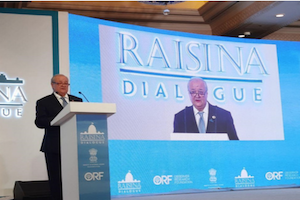
Afghanistan and the U.S. - Iran Confrontation
By Sudha Ramachandran
January 16, 2020, the CACI Analyst
The recent escalation of tension in the Persian Gulf following the assassination of a top Iranian general in a U.S. missile strike in Baghdad has set alarm bells ringing in the region. Iraq has already been dragged into the escalating U.S.-Iran tit-for-tat missile strikes. Given the fact that Afghanistan neighbors Iran and has a large presence of U.S. troops and facilities, the country risks becoming an additional battleground for the U.S.-Iran conflict, with potentially serious consequences for Afghanistan and the region.
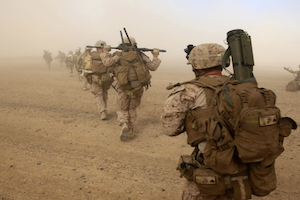
China's Soft Power in Central Asia
By Nurlan Aliyev
December 19, 2019, the CACI Analyst
On October 17-18, 2019, the 7th China-Central Asia Cooperation Forum, was held in Nanning, Guanxi province. The goal of the Forum was to further strengthen ties between China and the countries of Central Asia. Aside from its economic and security related interests in the region, China is also hoping to improve its image with the help of soft power influences, among populations where Sinophobic sentiments are strong. Despite several reports and information on Chinese projects with this aim, the question remains how effective China’s soft power in Central Asia really is.
